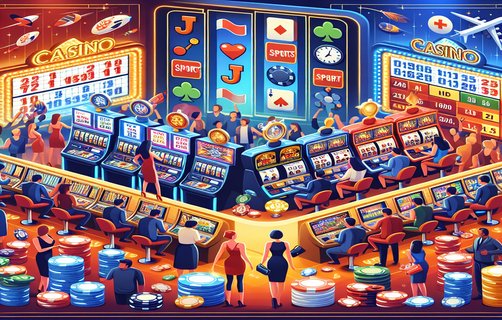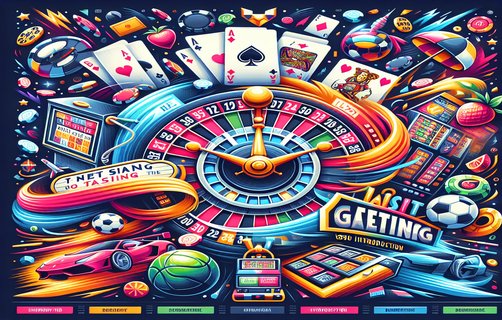The Art of Betting: Navigating Poker's Complex Landscape
पंपुनिक: पोकर का गहरा खेल
Poker is often seen as a game of luck and skill, but the intricacies of betting sizes introduce a deeper layer of strategy that can make or break a player's success. Understanding poker bet sizes involves grasping variable powers, rule exceptions, and the way chance, embodied in diceluck, influences outcomes.

Bet sizes in poker are not just numbers; they carry weight in terms of psychological warfare. A well-timed big bet can force opponents to fold, while a small bet may invite challenges. Variable powers come into play as different situations call for different approaches. For example, in a no-limit game, players may leverage larger bets to exert pressure, while in pot-limit games, the strategy often shifts based on the current pot size.
Furthermore, exceptions to the rules can dramatically alter strategies. In tournaments, for instance, the dynamics change significantly as players approach the bubble phase. Risk-tolerance metrics skew players' decisions, making understanding the timing of bets crucial. Here, it’s essential to analyze how players balance their aggression with caution as the stakes rise.
Dice luck can often lead to unexpected outcomes in poker. The randomness of a card draw can upend even the most skillful player's meticulously crafted strategy. However, skilled players can mitigate the effects of bad luck through calculated risks and a deep understanding of their opponents' tendencies—and this is further enhanced by game tiles and map-based boards that introduce unique mechanics.
In poker variants that utilize game tiles or map-based boards, each player's position can significantly influence betting choices and overall game flow. Balancing aggression and caution becomes a strategic dance, requiring constant reassessment of one’s opponents while keeping track of the evolving game landscape.
Thus, analyzing game flow balancing is vital. A player must adapt their betting strategy in accordance with shifts in game dynamics and player behavior, which can involve a complex mental calculus. As such, the true mastery of poker lies not only in the cards you hold but also in the bets you make. Every game unfolds as a unique narrative, shaped by the decisions made at each turn, revealing the delicate interplay of luck, strategy, and psychological insight.
पोकर अक्सर भाग्य और कौशल के खेल के रूप में देखा जाता है, लेकिन दांव के आकार की जटिलता एक दीर्घकालिक रणनीति की गहराई को पेश करती है, जो एक खिलाड़ी की सफलता को बना या बिगाड़ सकती है। पोकर दांव के आकार को समझने का मतलब है चर शक्तियों, नियमों के अपवादों और उस तरीके को पकड़ना, जिसमें मौका, डाइसलक के रूप में प्रकट होता है, परिणामों को प्रभावित करता है।
पोकर में दांव के आकार केवल संख्याएँ नहीं होतीं; वे मनोवैज्ञानिक युद्ध के संदर्भ में वजन करते हैं। एक सही समय पर बड़ा दांव विरोधियों को फोल्ड करने के लिए मजबूर कर सकता है, जबकि एक छोटा दांव चुनौतियों को आमंत्रित कर सकता है। चर शक्तियाँ तब महत्वपूर्ण होती हैं, जब विभिन्न परिस्थितियों के लिए विभिन्न दृष्टिकोणों की आवश्यकता होती है। उदाहरण के लिए, नो-लिमिट खेल में, खिलाड़ी बड़े दांवों का उपयोग दबाव डालने के लिए कर सकते हैं, जबकि पॉट-लिमिट खेलों में, रणनीति अक्सर वर्तमान पॉट के आकार के आधार पर बदलती है।

इसके अलावा, नियमों के अपवाद नाटकीय रूप से रणनीतियों को बदल सकते हैं। टूर्नामेंटों में, उदाहरण के लिए, जैसे-जैसे खिलाड़ी बबल चरण के करीब पहुंचते हैं, गतिशीलता काफी हद तक बदल जाती है। जोखिम-स्वीकृति मेट्रिक्स खिलाड़ियों के निर्णयों को विकृत कर देती हैं, जिससे दांवों के समय को समझना महत्वपूर्ण हो जाता है। यहां, यह बिल्कुल आवश्यक है कि खिलाड़ी अपने आक्रामकता और सतर्कता के संतुलन का विश्लेषण करें क्योंकि दांव बढ़ते हैं।
डाइस लक पोकर में अक्सर अप्रत्याशित परिणामों की ओर ले जा सकता है। कार्ड ड्रॉ की बेतरतीबी ने एक सबसे कुशल खिलाड़ी की सावधानीपूर्वक तैयार की गई रणनीति को उलट सकता है। हालांकि, कुशल खिलाड़ी खराब भाग्य के प्रभाव को कम कर सकते हैं विचारशील जोखिमों और अपने विरोधियों की प्रवृत्तियों की गहरी समझ के माध्यम से—और यह विशेषताएं गेम टाइलों और मानचित्र आधारित बोर्डों द्वारा और भी बढ़ाई जाती हैं जो अद्वितीय तंत्र पेश करते हैं।
पॉकर वेरिएंट में, जो गेम टाइलों या मानचित्र आधारित बोर्डों का उपयोग करते हैं, प्रत्येक खिलाड़ी की स्थिति दांव के विकल्पों और समग्र खेल प्रवाह को महत्वपूर्ण रूप से प्रभावित कर सकती है। आक्रामकता और सतर्कता का संतुलन एक रणनीतिक नृत्य बन जाता है, जो खिलाड़ियों को प्रत्येक कोने पर अपने विरोधियों का निरंतर पुनर्मूल्यांकन करने की आवश्यकता होती है, जबकि वे विकसित होते खेल परिदृश्य को ट्रैक करते हैं।
इस प्रकार, खेल प्रवाह संतुलन का विश्लेषण महत्वपूर्ण है। एक खिलाड़ी को खेल डायनामिक्स और खिलाड़ी व्यवहार में परिवर्तनों के अनुसार अपनी दांव की रणनीति को समायोजित करना चाहिए, जिसमें एक जटिल मानसिक कैलकुलस शामिल हो सकता है। इस प्रकार, पोकर में असली मास्टरशिप केवल आपके पास कार्डों में नहीं बल्कि आपके द्वारा किए गए दांवों में भी है। हर गेम एक अनोखा किस्सा बन जाता है, जो हर मोड़ पर किए गए निर्णयों से आकार लेता है, जो भाग्य, रणनीति और मनोवैज्ञानिक अंतर्दृष्टि के बीच नाजुक अंतर्संबंधों को प्रकट करता है।

comments
PokerGuru29
This article offers an amazing perspective on betting strategy!
CardShark88
I love how you emphasized the psychological aspects of poker betting.
BluffMaster
Great insights! Dice luck really does play a crucial role in poker.
ChipsAndBluff
The section on variable powers is especially enlightening. Thanks for sharing!
GamblerQueen
Interesting take on game flow balancing in poker.
RaiseYourGame
This analysis perfectly captures the complexity of poker. Well done!